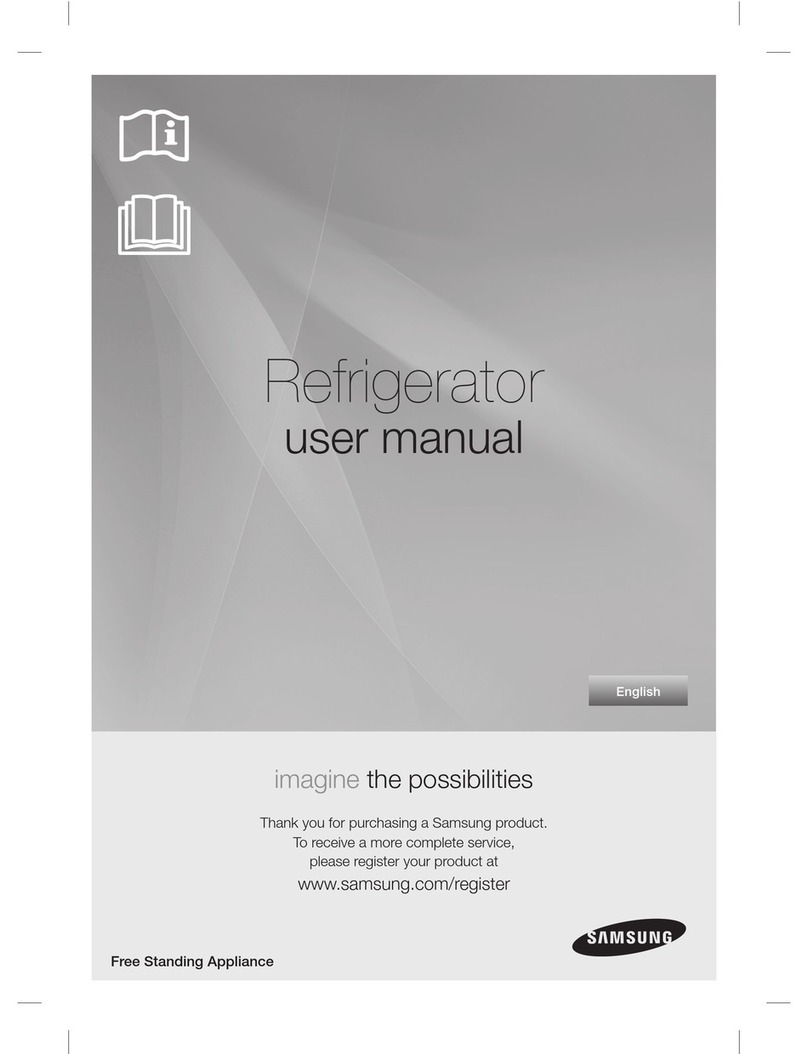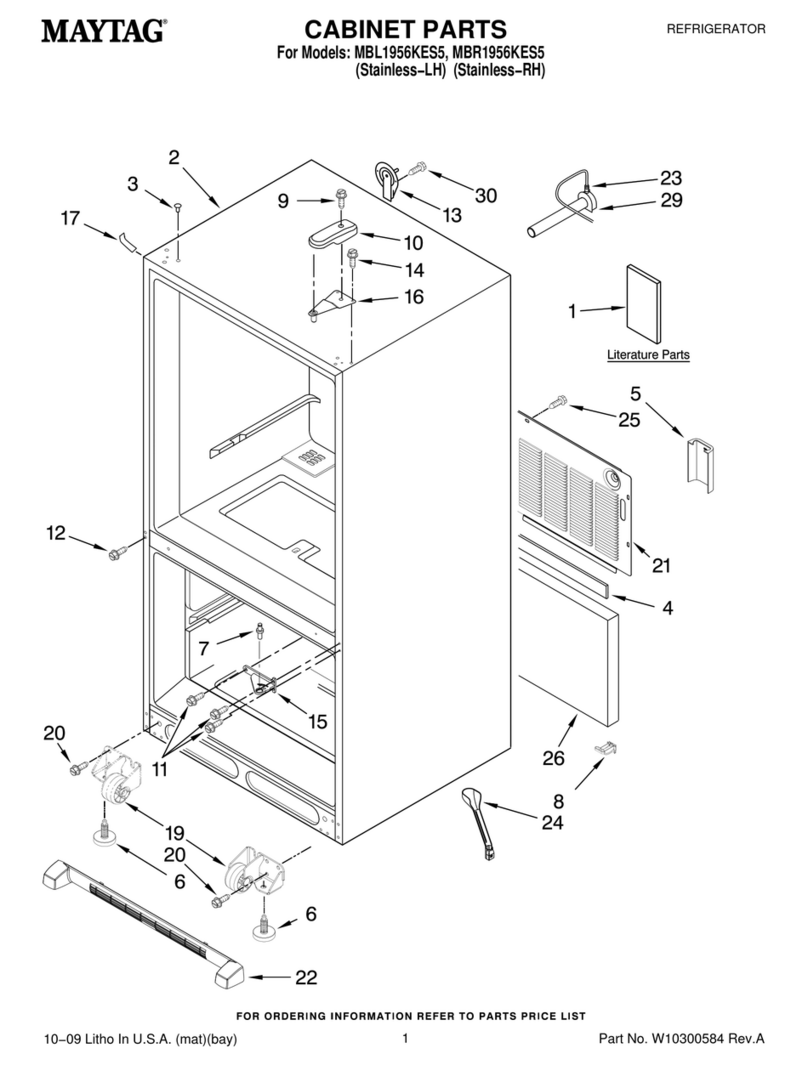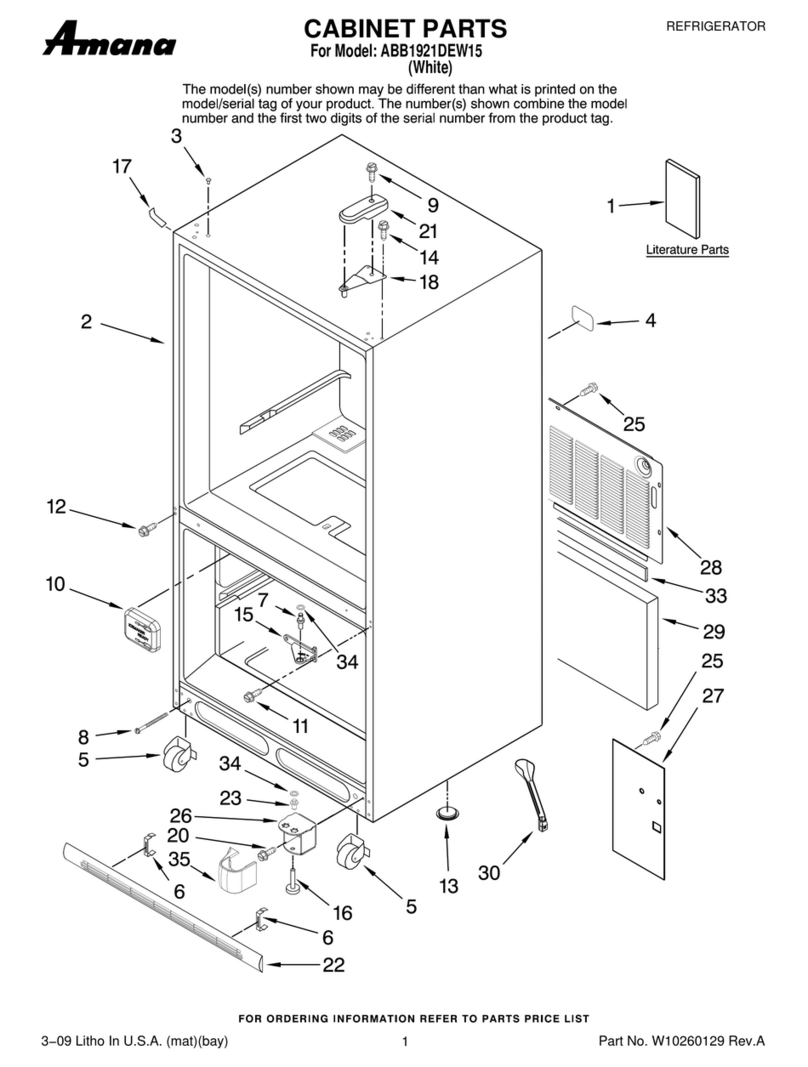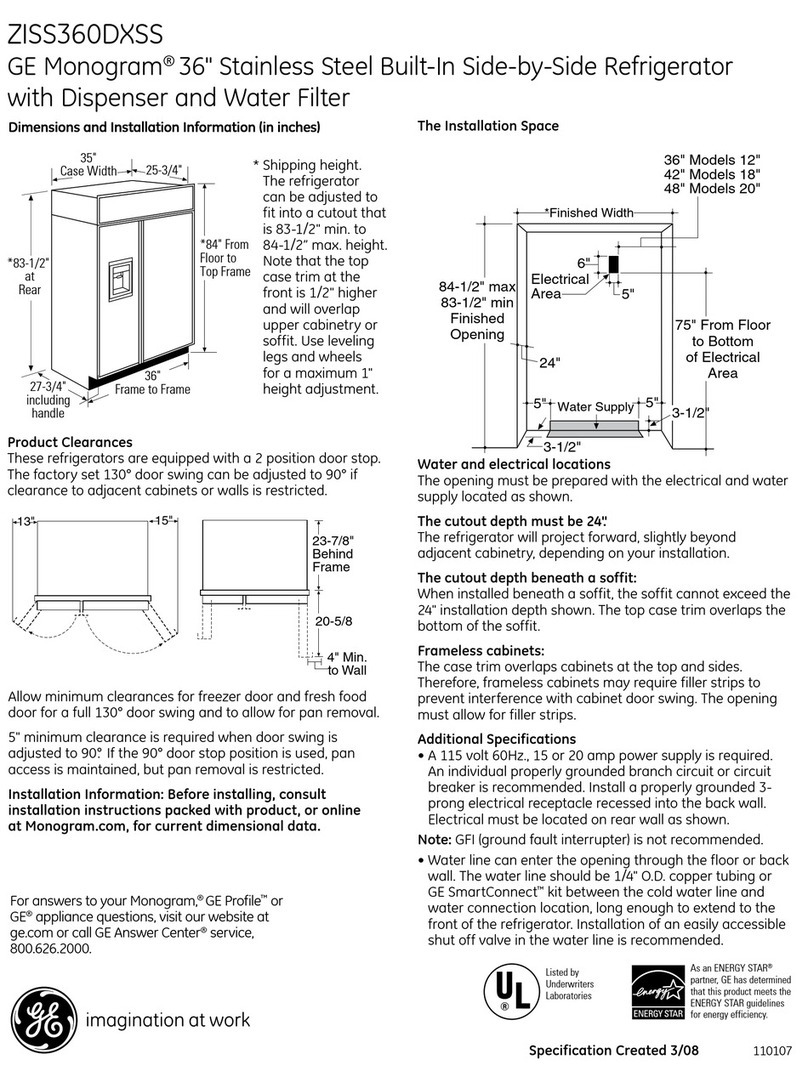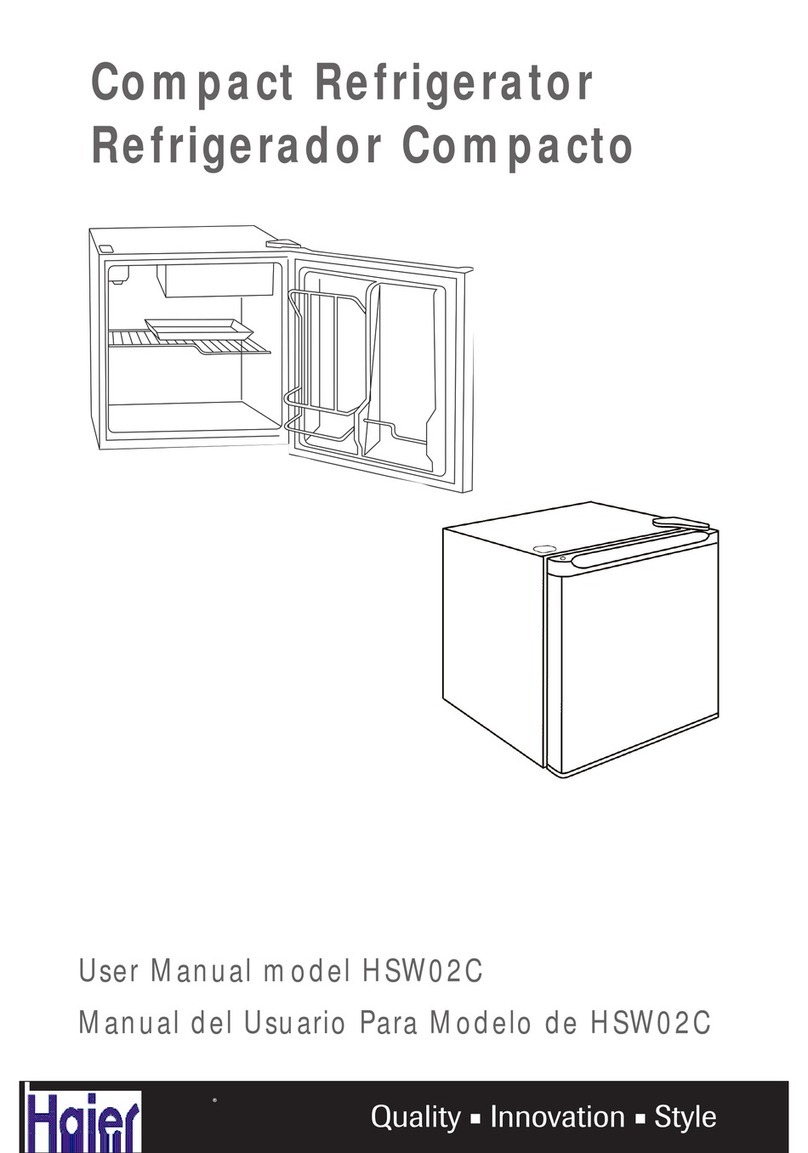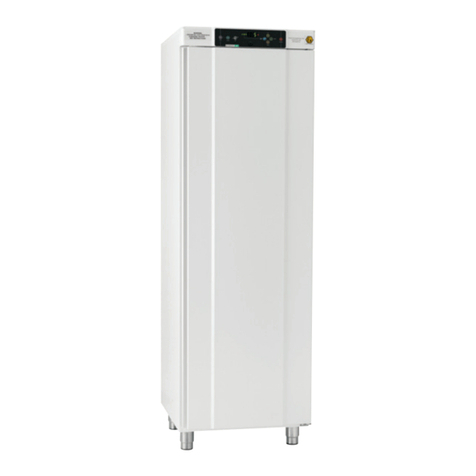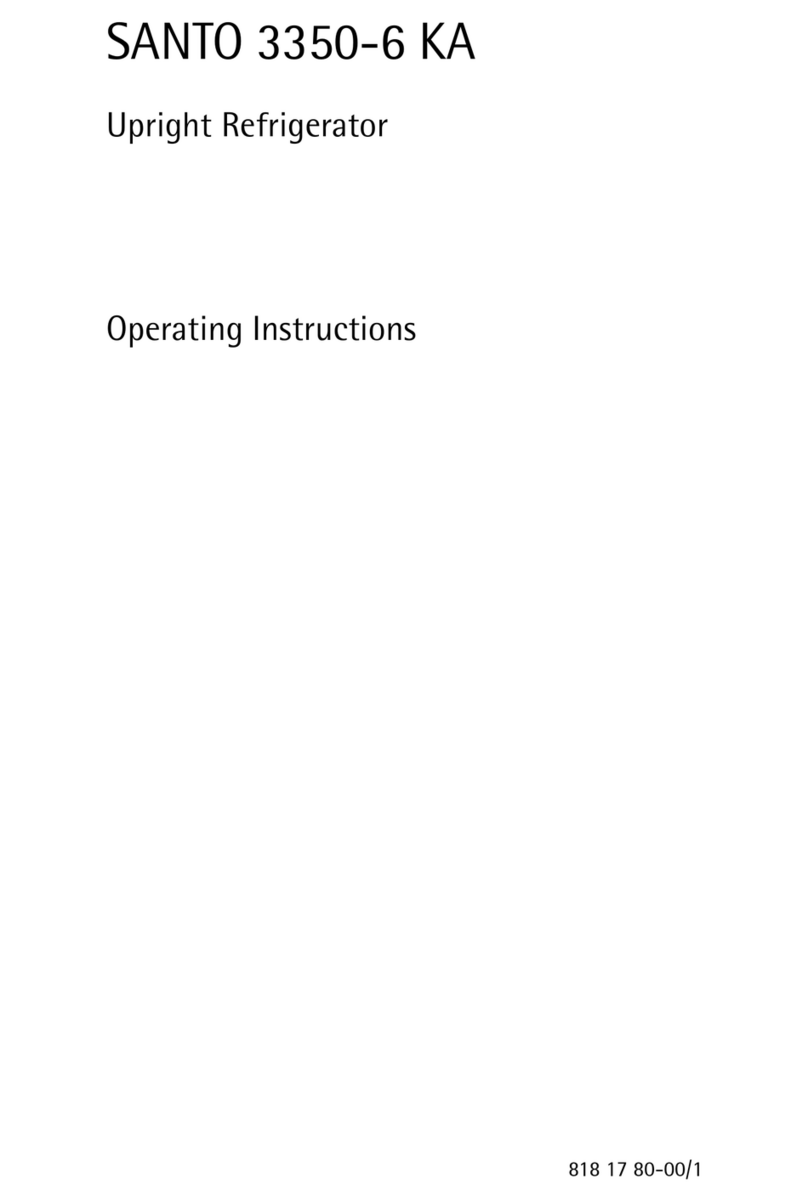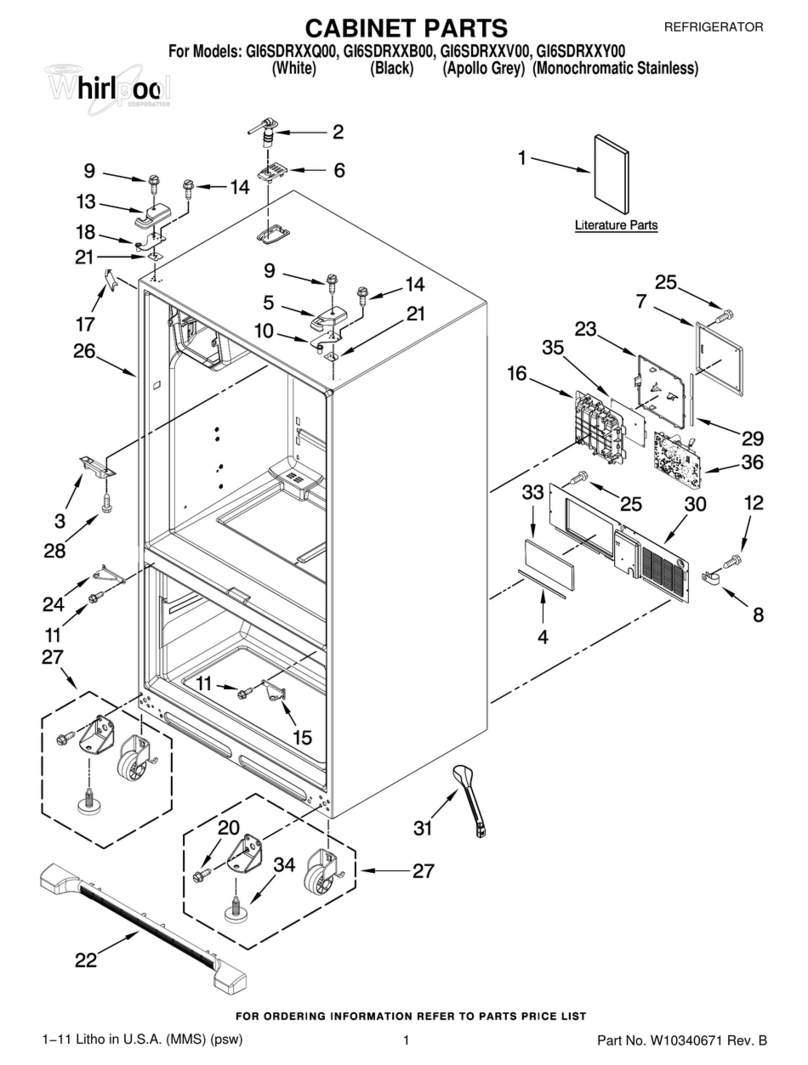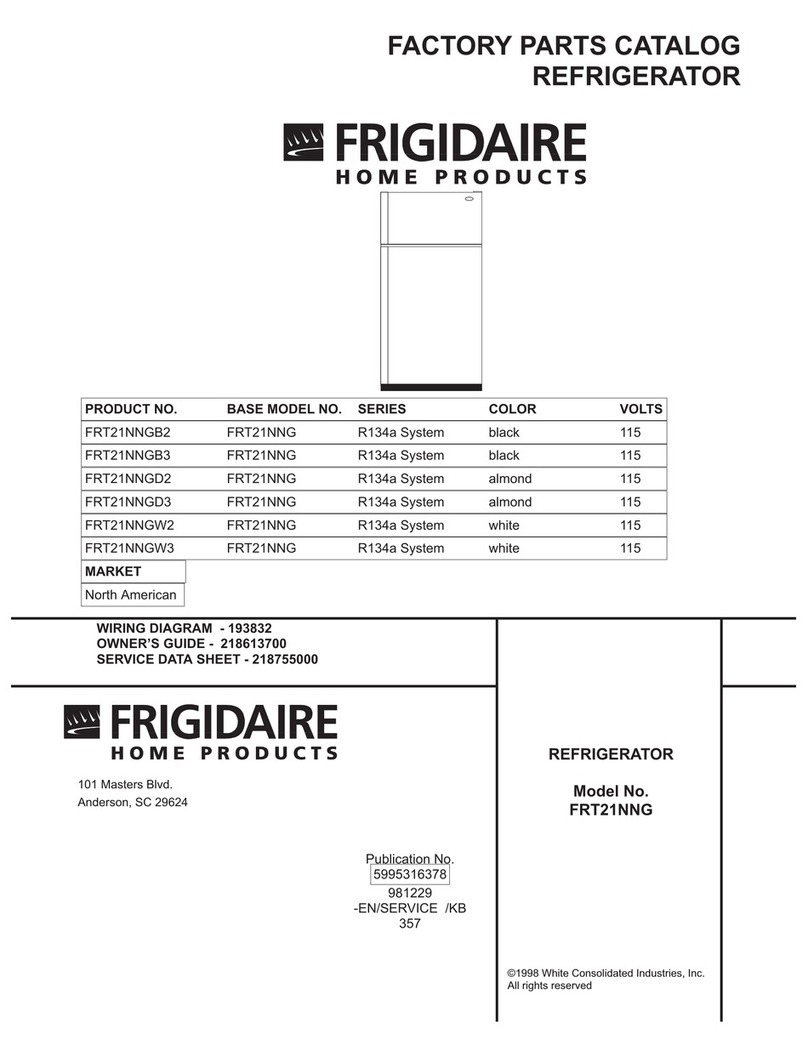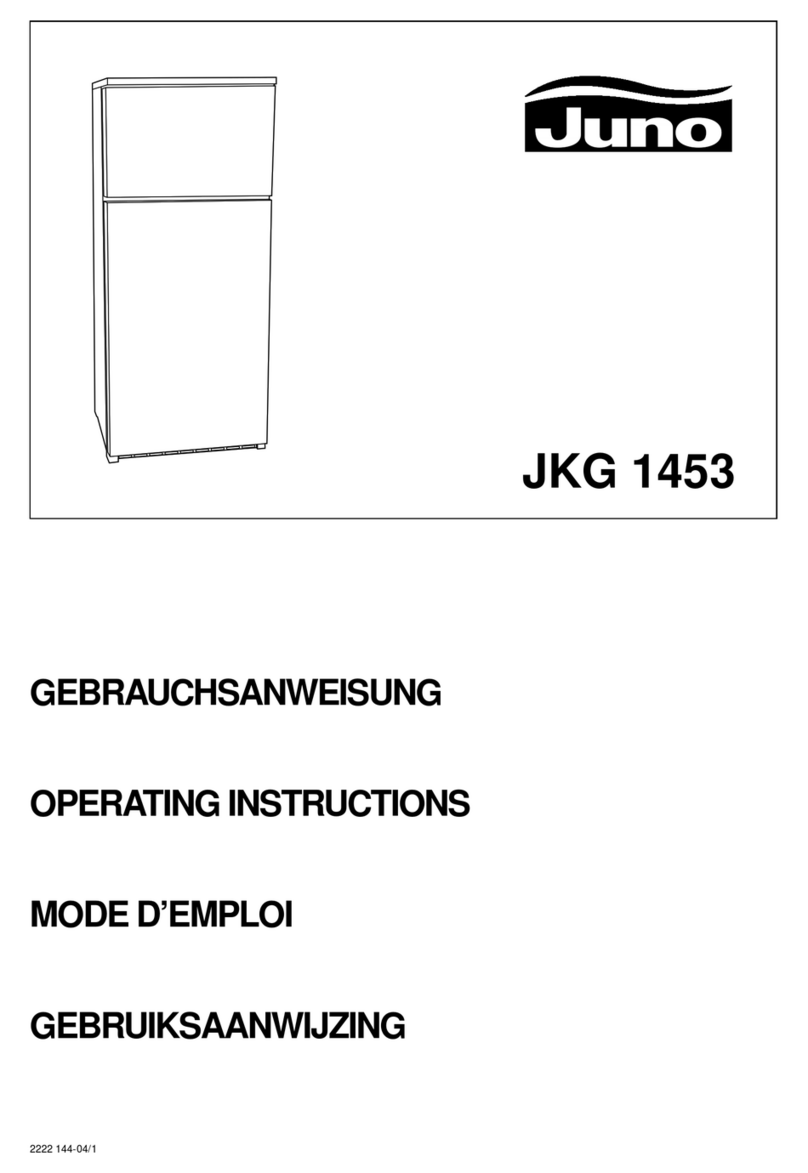Bravo XC-62GAS User manual

- 1 -
INSTRUCTION MANUAL
12V - 230V –LP GAS
DO NOT OPERATE THIS APPLIANCE BEFORE READING THE INSTRUCTION
BOOKLET.
DO NOT STORE CHEMICALS OR FLAMMABLE MATERIALS, OR SPRAY AEROSOLS
NEAR THIS APPLIANCE.
DO NOT OPERATE THIS APPLIANCE USING LPG IN VEHICLES, BOATS OR
ENCLOSED AREAS.
Keep this Instruction Manual for future reference.
3-WAY ABSORPTION UPRIGHT
CAMPING FRIDGE
MODEL NO.: XC-62GAS

- 2 -
Installation of the fridge.
Make sure this fridge is in good working order before you use it. If you suspect there is a problem take it to an
appropriate servicing agency.
Install the appliance on a firm horizontal and levelled surface.
The distance between the rear of the unit and a wall must be at least 10 cm. The minimum distance to be
observed on the sides shall be at least 5 cm.
Avoid placing the appliance in direct sunlight or near any source of heat.
Do not cover the ventilation openings at the top and/or back.
Products to be stored in the fridge must be pre-cooled. Never put hot products inside.
Do not store flammable or explosive products. Always use plastic containers and bottles for storing products.
Ensure there is space around the contents for circulation of cold air.
Complying with the above will ensure efficient and economical cooling.
Make sure this fridge is in good working order before you use it.
Ensure only one source of energy is used at one time.
This appliance is not intended for use by persons (including children) with reduced
physical, sensory or mental capabilities, or lack of experience and knowledge, unless
they have been given supervision or instruction concerning use of the appliance by a
person responsible for their safety.
Children should be supervised to ensure that they do not play with the appliance.
Ensure this appliance isn’t exposed to rain, water and/or splashing.
If the supply cord is damaged, it must be replaced by the manufacturer, its service agent
or similarly qualified persons in order to avoid a hazard.
Identification

- 3 -
Operation using mains power –230v/50Hz.
Never use another source of energy at the same time (battery or gas). Ensure that the Gas hose and 12V DC
plug is not connected.
Check that the mains voltage corresponds to the operating voltage specified on the technical data label at the
back of the appliance.
If the electrical specifications are correct, plug the safety electrical connector into an earthed wall socket, which
is wired according to ruling regulations.
Turn the 230V thermostat knob (left) clockwise to MAX position.
After about one hour the effects of the cooling process will become visible: frost on the inside evaporator.
The thermostat enables the temperature of the fridge to be adjusted. After a cooling period of about 5 hours,
the thermostat can be set on a desired position; this position is influenced by the surrounding temperature and
the intensity of use. At the position min. the cooling process is stopped. The appliance is switched off by
removing the plug from the wall socket.
Operation using a battery (12 Volt DC).
Do not use another source of energy at the same time (mains or gas). Ensure that the Gas hose and 230V AC
plug is not connected.
A safety fuse must be installed in the power supply line between the battery and the fridge.
It is not necessary to check the polarity when starting up the appliance. Verify the voltage of the battery with
the voltage indicated on the technical data label at the back of the appliance.
When the appliance is powered by a motor vehicle battery, only switch the fridge on while the vehicle engine is
running.
When using a battery as a power source, there is no thermostatically controlled temperature regulation.
Pre-cool the fridge on the mains before starting a journey and try to put only pre-cooled or frozen products in
the fridge.
To start up the unit connect the supplied cable at the back in the 12v socket and put the corresponding side into
the cigar lighter socket of the vehicle. To disconnect, remove the connector from the cigar lighter socket.
IMPORTANT:
If the appliance remains switched on when the vehicle is stopped, the battery will be
discharged and it may be impossible to restart the vehicles engine.
Operation using LP Bottle Gas.
Operation on gas is prohibited in closed areas, in vehicles and on boats. The appliance must be used in a well
ventilated area when operating on gas. This means that it can also be used under the canopy of a tent if
sufficiently ventilated. In all cases the location should be protected from rain and/or splashing.
Do not use another source of energy at the same time (12v or 230v). Ensure that the 12V DC plug and 230V
plug are not connected.
The gas cylinder must be stored in a cool, dry, ventilated area. Protect from sunlight and do not expose to
high temperatures.

- 4 -
Connecting to an LPG cylinder:
Only use approved gas pressure regulator (regulated to 2.75kPa). Note: Pressure regulator is not supplied.
The gas inlet on this fridge is ¼” BSP Parallel or ¼” BSP Union. The thread required is RH ¼” BSP.
The appliance cannot operate at a pressure other than the one specified.
During connection of the fridge to the gas cylinder, always stay clear of any sort of ignition and do not smoke.
Connect in the order; gas cylinder –pressure regulator –appliance.
Excessive twisting and bending of the flexible hose must be avoided.
The gas valve knob (right) is a combination of temperature control and ignition. Furthermore the gas valve
assembly consists of an incorporated safety pilot, a burner with an ignition plug and a piezo-electric igniter.
The safety pilot automatically maintains the gas supply as long as it remains lit. It automatically shuts off the
supply of gas if the flame goes out.
Leak Test:
Open the gas valve of the gas cylinder. Once the gas connections have been sufficiently tightened, use a
soapy water solution to check connections for gas leaks. There are no leaks if no bubbles form. Never check
for leaks using a flame.
Starting your fridge on LPG:
Press and hold down the gas control knob on the control panel, wait approx 15 seconds to prime the gas (this
allows the gas to bleed through the burner), with the control knob still pressed in, turn knob to the right until
you hear the click of the piezo ignition. Hold the knob pressed in this position and check if the burner is alight
by checking that the needle on the pilot light gauge is in the green section, then release the knob.
It might be possible that this priming operation has to be repeated a couple of times, especially if the appliance
has not been used for a long time or if the gas cylinder has been changed. There can be air in the system,
which has to be forced out. You may also check that the pilot is lit by looking through the viewing port hole
located at the rear bottom left hand corner of the fridge.
If the flame fails to light, wait at least a minute before trying again.
If the needle moves out of the green area this would indicate gas flow has stopped and the pilot light has gone
out. If this should occur, follow the instructions to relight the unit.
Leave the knob for some time in max position; after a sufficiently long cool down period, a lower position can be
selected.
Turning off the fridge off:
When changing the gas cylinder or disconnecting the hose, it is necessary to close the valve of the gas cylinder.
To disconnect the fridge running on gas: close the valve of the gas cylinder and then turn the gas valve knob in
the panel to the ‘press’ position.
When using LPG ensure fridge is in a well-ventilated area, where fresh air is circulating.
Position the gas cylinder so that the hose is not kinked or stretched.

- 5 -
Maintenance and storage.
The fridge must be defrosted regularly in order to ensure a correct operation. To defrost the appliance,
disconnect it, empty it and if necessary use a cloth with warm water. Dry and clean the inside with a
non-abrasive cloth. Never use a knife or other sharp tool to remove ice.
If the appliance is to remain unused for a longer period, disconnect it, clean it and leave the door slightly open
during storage to prevent unpleasant odours. Put some talcum powder in the gasket of the lid.
Do not store in dusty areas. Cover over unit while stored to protect against build up of dust or insects nesting
inside the burner.
It is recommended that adequately cover the burner outlets to protect against insects nesting inside the burner.
Maintenance should be carried out every 12 months and/or before use after the fridge has been stored for a
long period of time.
All repairs and maintenance must only be undertaken by a suitably qualified technician.
Do NOT attempt to modify any part of this fridge as it may lead to serious injury or even death.
Always replace a damaged or porous hose.
Disposal.
If you wish to dispose of this fridge, please contact your local authorities to ask for the correct way of disposal.
Troubleshooting
If a problem occurs, first carry out the following checks:
Is the appliance installed in a horizontal position?
Is there sufficient ventilation?
For 230v AC mains operation; check the mains supply is correct and if the thermostat knob is set correctly.
For 12v DC battery operation; check the battery is sufficiently charged and if the thermostat knob is set
correctly.
For Gas operation; check the burner is ignited.
Is there still a sufficient quantity of gas in the gas cylinder?
Is the gas valve open?
Has the gas valve knob been pressed long enough before ignition? Good priming is key to a successful
ignition.
Has the thermostat knob been set to MAX position?
Have two modes of energy operation been selected at the same time?
Has too much food been placed inside the refrigerator all at once? Air needs to freely circulate inside the
refrigerator.
If after a period of time the refrigerator does not cool down, switch it off and leave it turned upside down for 1
hour then put it the right way up and connect again.

- 6 -
Name of Appliance Bravo
Model No. XC-62GAS
Capacity 60 L
Climate Class T
Coolant Ammonia (NH3 –125g)
Insulation Cyclopentane
Battery Input 12V / 100 W / 8.33 A
Power Input 230 V / 100 W / 0.43 A
Power Consumption 1.5 kWh/24h
Gas General Product LPG
Gas Pressure 2.75 kPa
Gas Consumption 13g/h
Injector Size 0.22mm (+- 0.02)
Weight 21kg
STM Group (New Zealand) Limited
16 Parkhead Place, Albany, North Shore 0632
PO Box 100-216, North Shore 0745, New Zealand
Tel: +64 9 9149400 Fax: +64 9 9149410
Toll Free 0800 804646
www.stmgroup.co.nz
Table of contents
Popular Refrigerator manuals by other brands
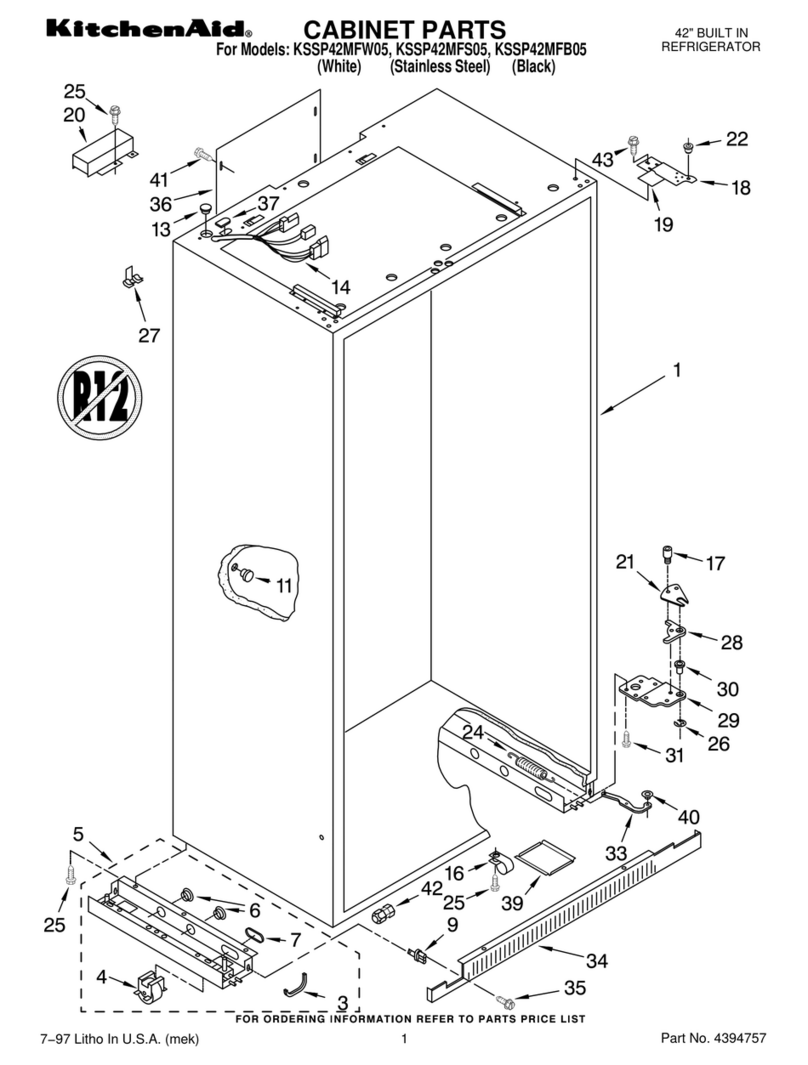
KitchenAid
KitchenAid KSSP42MFB05 parts list
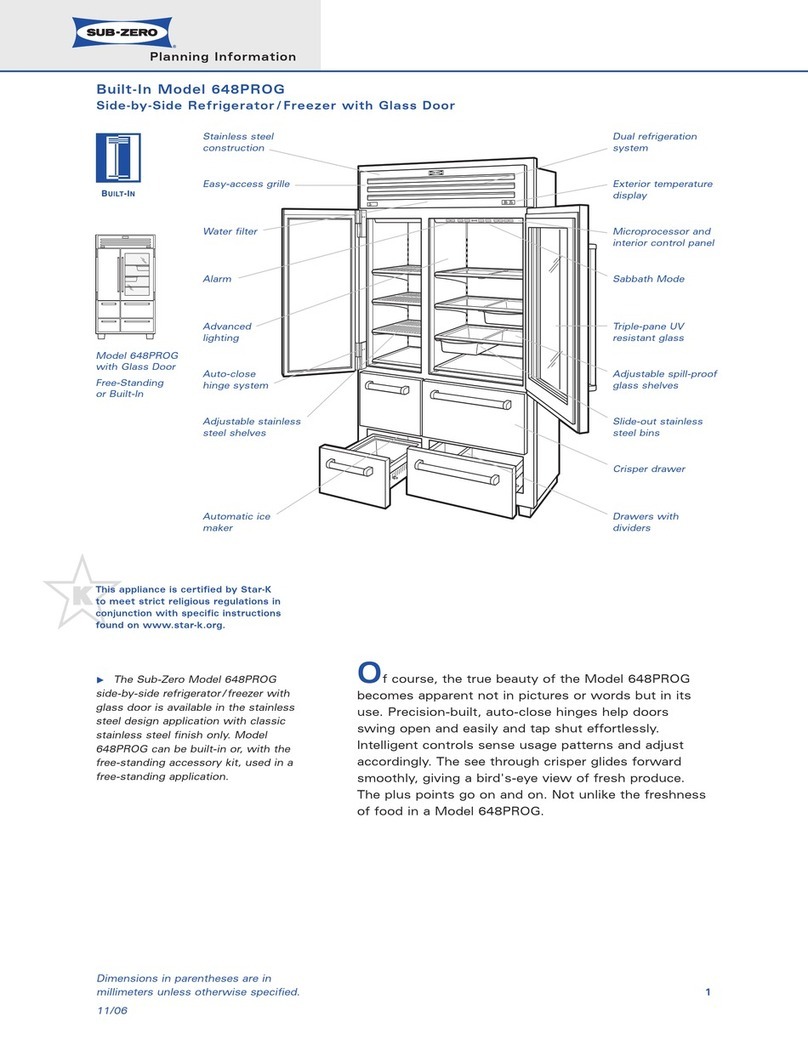
Sub-Zero
Sub-Zero Sub-Zero 648PROG Specifications
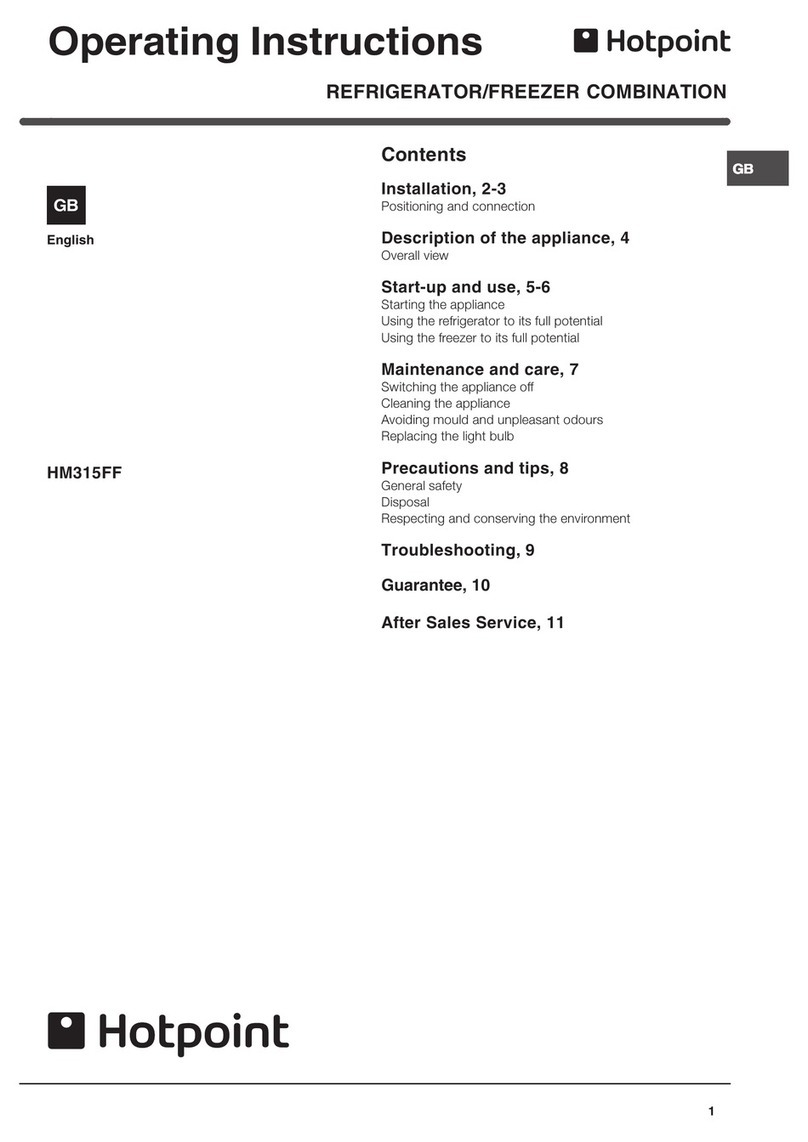
Hotpoint
Hotpoint HM315FF operating instructions
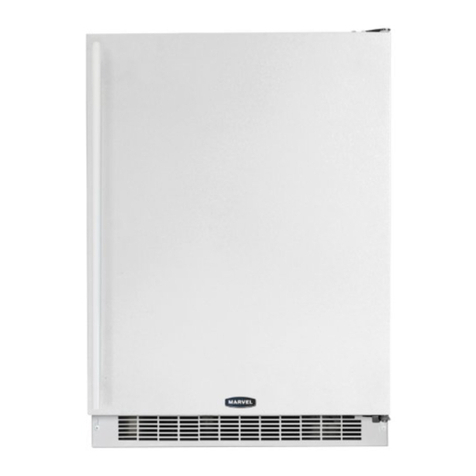
AGA marvel
AGA marvel Marvel 61RF Operating and maintenance instructions
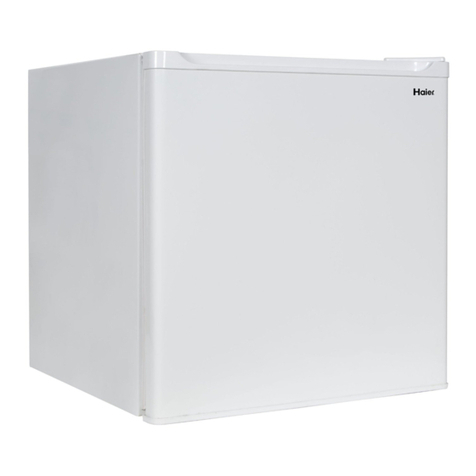
Haier
Haier HC17SF10R Installation and user manual
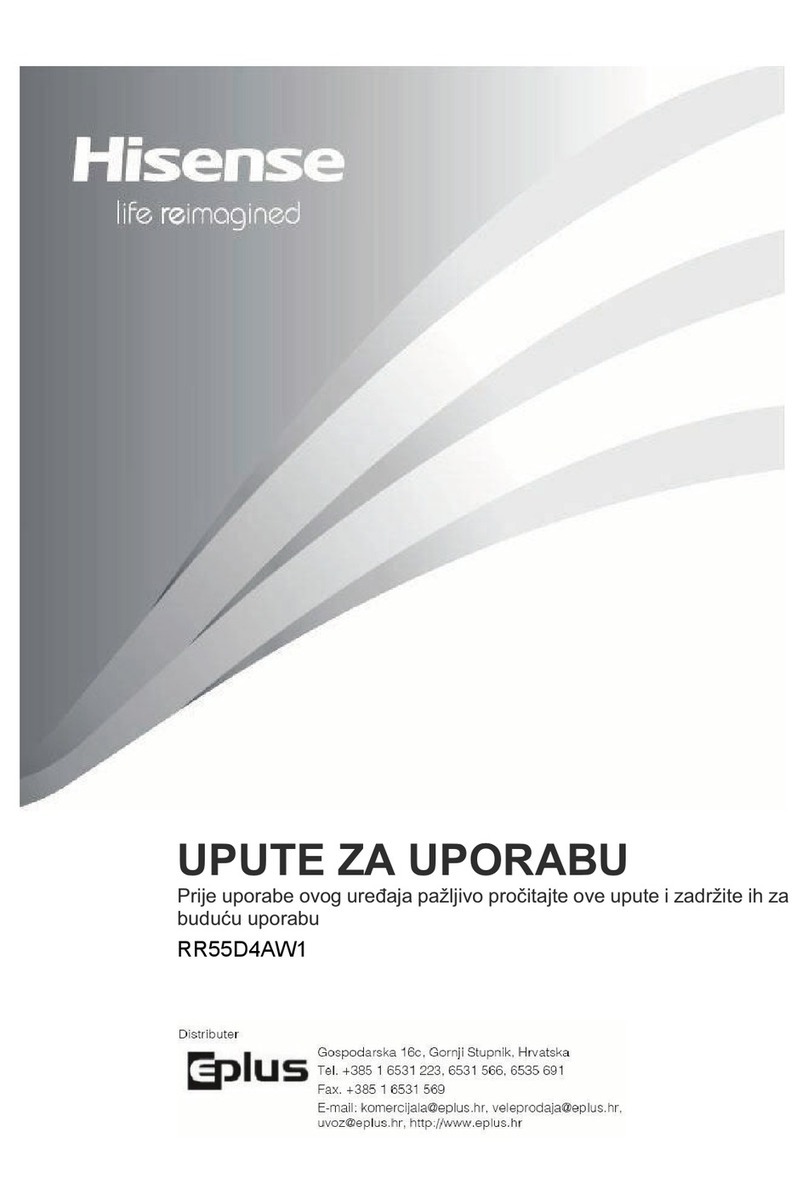
Hisense
Hisense RR55D4AW1 User's operation manual
